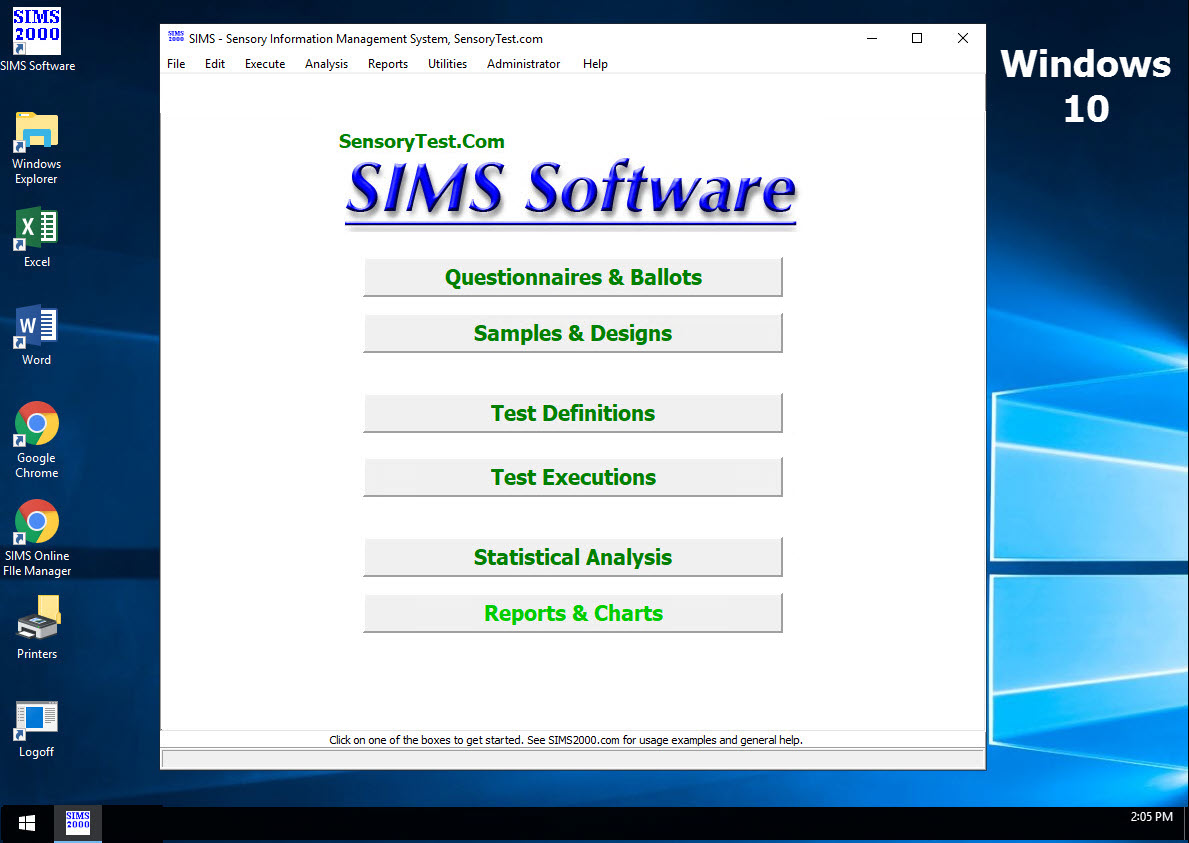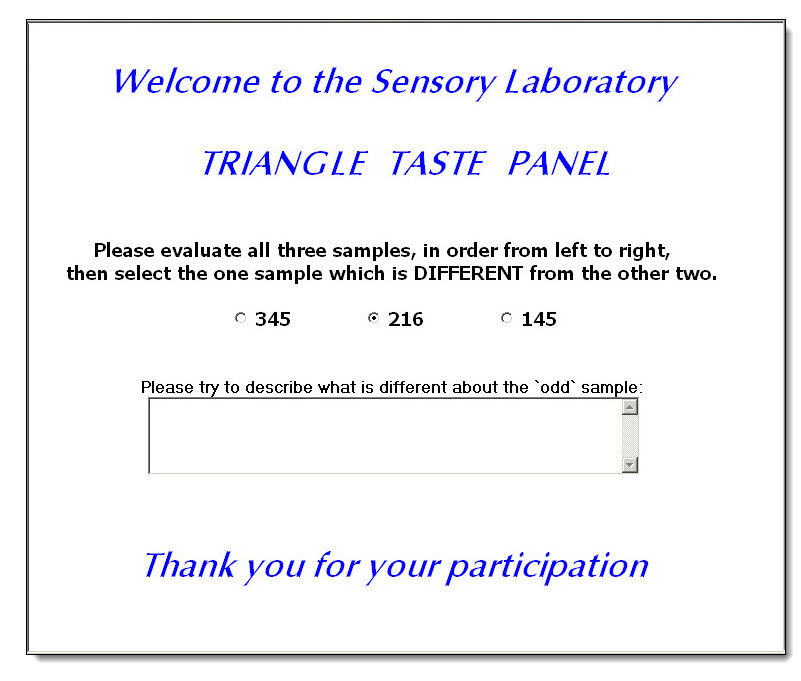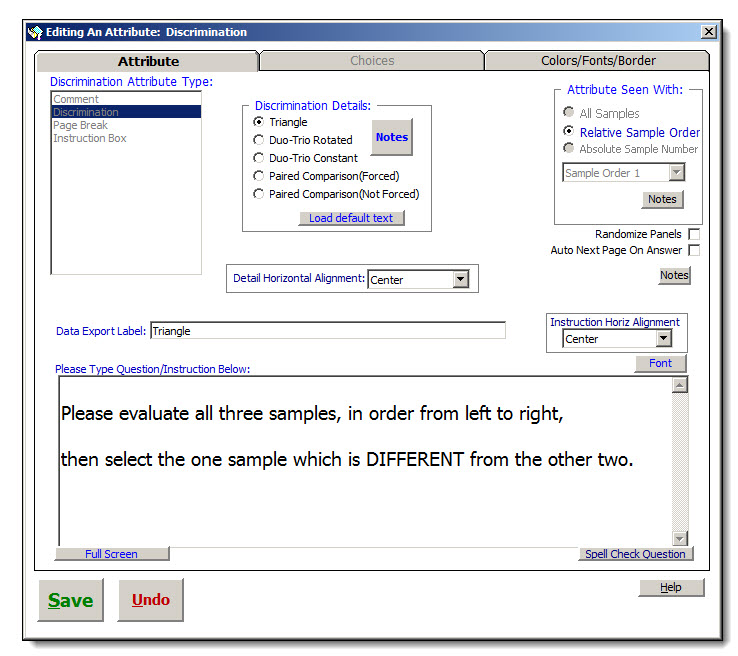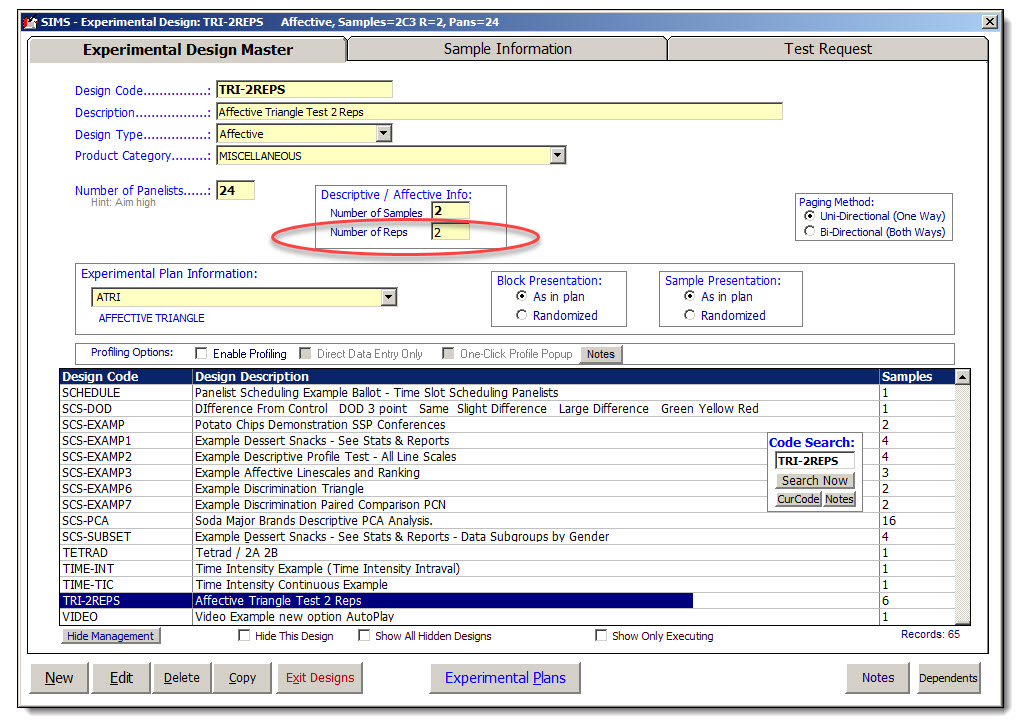
 HOME
HOME CONTACT
CONTACT SUPPORT
SUPPORT SENSORYTEST.COM
SENSORYTEST.COM |
 HOME HOME CONTACT CONTACT SUPPORT SUPPORT SENSORYTEST.COM SENSORYTEST.COM |
|
Sensory testing professional's favorite virtual desktop. Say hello to SIMS Cloud Systems. From any device, any laptop, any iPad and even your cell phone. Log in from anywhere anytime. Inquire today. 
|
Mobile devices real test example Point your cell phone camera Easy for your respondents 
Link |
 VIEW REPORTS
VIEW REPORTS |
 QUESTION CHOICES
QUESTION CHOICES |
 TEST CHOICES
TEST CHOICES |
| Discrimination Triangles Examples | View More Question Type Choices |
Here's a live running example triangle test: Take Test.

Ballot Setup - Very Easy 
SIMS software express package file: SCS-EXAMP6.SIMS2000ExpressPackage.sql.ZIP |
Triangle Discrimination - Correct/Incorrect SIMS Report 
Triangle Discrimination - Correct/Incorrect SIMS Report 
Report Setup 
|
| Triangle Test Blinding Codes from Multiple Pulls - Example Setup 
|
| Triangle 2 Reps - Example Setup Ballot 
Triangle 2 Reps - Example Setup Experimental Design 
Example of Affective Triangle Test with 2 Reps SIMS software express package file: TRI-2REPS.SIMS2000ExpressPackage.sql.ZIP |
*** Discrimination Attributes - Notes ***
-----------------------------------------------
Use Discrimination questions to test for the perception
of small differences in sample stimuli.
Triangle
========
Panelist is presented with three coded samples, two of which are identical.
The panelist is asked to pick the sample which is different from the others.
Example: Please evaluate all three samples, in order from left to right,
then select the one sample which is different from the other two.
Result Data Values for Discrimination Triangle Tests: 1=Correct 0=Incorrect
Discrimination triangles employ the standard triangle sample rotation plan AABB of 6 blocks:
Block Number Sample Order 1 Order 2 Order 3
1 1 2 1
2 2 1 2
3 1 1 2
4 2 2 1
5 1 2 2
6 2 1 1
Multiple Reps Discrimination:
Use Affective ballot triangle when additional ballot functionality is needed beyond traditional Discrimination.
Affective triangle studies also allow for flexible custom sample ordering experimental plans and multiple reps.
Advanced: Automated Triangle Test Blinding Codes from Multiple Pulls. See Print Screens Below.
Rotated and *specific* sample multiple blinding codes. And balanced presentation.
This differs from the SIMS standard options for 'Same Blinding Codes All Panelists.'
and 'Different Randomly Generated Blinding Codes All Panelists.'
AABB 1 Pull, AA BB, utilize exactly *four* unique blinding codes.
Example file: SIMS_Software_Triangle_Blinding_Codes_AABB_from_AABB_1Pull.xls
AAABBB 2 Pulls, AAA BBB, utilize exactly *six* unique blinding codes.
Example file: SIMS_Software_Triangle_Blinding_Codes_AABB_from_AAABBB_2Pulls.xls
AAAABBBB 2 Pulls, AAAA BBBB, utilize exactly *eight* unique blinding codes.
Example file: SIMS_Software_Triangle_Blinding_Codes_AABB_from_AAAABBBB_2Pulls.xls
AAAAAABBBBBB 3 Pulls, AAAAAA BBBBBB, utilize exactly *twelve* unique blinding codes.
Example file: SIMS_Software_Triangle_Blinding_Codes_AABB_from_AAAAAABBBBBB_3Pulls.xls
Forum Topic: https://www.sensorycomputersystems.com/phpbb2scs/viewtopic.php?t=119
Triangle Statistics:
Binomial Distribution Analysis. This is the calculation for Confidence Levels and P-Values.
Reference: Sensory Evaluation Techniques, by Meilgaard, Civille, and Carr.
Critical Number of Correct Responses in a Triangle Test, the minimum number of correct responses required for significance for a given number of respondents.
4th Edition, Table 17.8 page 433. Also see chapter 6.3 pages 65-72.
3rd Edition, Table T8 page 369. Also see chapter 6.III pages 61-66.
2nd Edition, Table T7 page 338. Also see chapter 6.II pages 60-65.
Duo-Trio (Rotated or Constant)
==============================
Panelist is presented with two coded samples and an identified reference sample.
One of the coded samples will be identical to the reference sample.
The panelist is asked to choose which of the two coded samples is different
from (or identical to) the reference sample.
There are two types of Duo-Trio sample presentations:
Rotated - the reference sample is ROTATED between the the two test samples.
Constant - the reference sample is always CONSTANT as the control sample.
Example: Please evaluate the samples in order from left to right,
then select the sample which is the same as REF.
Both DTR & DTC Questionnaire 'Seen With' Relative Sample Order 1. Two Choices ( ) 111 ( ) 222.
Designs are 2C3. Experimental Plans are DDTR (4 blocks 1 2 1 2 1 2 1 1 2 2 2 1) and DDTC (2 Blocks 1 2 1 1 1 2).
Result Data Values for Discrimination Duo-Trio Tests: 1=Correct 0=Incorrect
Paired Comparison
=================
Panelist is asked to compare two samples on the basis of some specifically
defined criterion. There are two types:
Forced - The panelist must select one of the two samples. (PC)
Not Forced - The panelist can select 'Neither' to mean both samples are the same. (PCN)
Optional: See Choices Tab to select custom text for No Preference.
Example: Please select the sample that is sweeter.
Result Data Response Values for Discrimination Tests (PCN, PCF), the Absolute Sample Number SELECTED by the panelist.
Most Reports in SIMS will report PCN PCF response data values as:
1 = Absolute Sample 1 selected 2 = Absolute Sample 2 selected . = No Preference
Such as Test Data Results Report, Test Raw Data Excel Exporting, etc.
For the editing raw test data area, and in the SQL database:
Paired Comparison Data value '1' means Panelist selected Absolute Sample 1
Paired Comparison Data value '0' means Panelist selected Absolute Sample 2
If PCN & No Preference selected, response value is Null '.'
Paired Comparison Reports:
- See Statistics areas, Discrimination Binomial Analysis.
- See Reports dropdown menu, Discrimination Reports, Paired Comparison Attribute Analysis.
- See Reports dropdown menu, Raw Data Exporting.
- And other reports.
2-AFC (Alternative Forced Choice) is also known as a Paired Comparison Test.
- Use this method to test for sensory differences between two samples, such as 'which sample is sweeter'.
- set up your 2-AFC as a Paired Comparison test, with PC or PCN, where an answer is forced or not forced.
- Same SIMS Paired Comparison Attribute Analysis, in addition to the other available reports.
- Reference #1: Sensory Evaluation Techniques, Civille, 3rd Ed.(pg 100), 2nd Ed.(pg 100).
Incomplete Block Paired Comparisons
Also commonly referred to as multiple paired comparison, multiple paired preference, pairwise ranking, and incomplete block paired preference.
Can not use the typical Discrimination PC since a 2 sample, complete block design is required.
Incomplete blocking such as 3C2, 4C2, 5C2, etc., when Samples >=3, and presenting only two samples.
Two alternative methods:
1) Ranking; Paired Comparison is similar to Pairwise Ranking.
Use an Affective type Questionnaire, SIMS Ranking Attribute question, 'rank all'.
2) Hedonic; using SIMS hedonic attribute type, 'select one'.
Set up the ballot as an Affective questionnaire using Hedonic Attributes instead of the typical two sample Discrimination PC.
Affective questionnaire will allow for more flexible Incomplete Block Experimental Design and Experimental Plan Rotations.
Create an Hedonic attribute type with two choices and label the choices them with the following special TAGs.
<RELATIVE_SAMPLE_1_BLINDING_CODE> select the choice return value to be = 1
<RELATIVE_SAMPLE_2_BLINDING_CODE> select the choice return value to be = 2
The above example will present two choices with the blinding codes for the two samples in randomized order
perfectly matching the Rotation Plan in the Test Definition.
Example: Which Sample do you prefer OVERALL?
( ) 135 ( ) 246
Note: The 'Attribute Seen With:' option should be set to 'Relative Sample -- Last Sample', so that this question is only seen once at the end of the ballot.
Note: See Webpage: https://www.SIMS2000.com/Sample11.asp for additional and the latest information.
Positioning of Discrimination Attributes in Affective Questionnaires
====================================================================
There are several guideline rules to follow when including a Discrimination
Attribute in an Affective Questionnaire:
1. The Discrimination Attribute must be either 'Seen With Sample Order 1'
or 'Seen With Sample Order 2.' or 'Seen With Last Sample'.
2. If a Discrimination Attribute is Seen With Sample Order n, then
all discrimination attributes in the same questionnaire must also
be Seen With Sample Order n, where n = 1 or n = 2 or 'Seen With Last Sample'.
3. All attributes seen on the same page as a Discrimination Attribute
must be seen with same sample as the Discrimination Attribute.
4. You can include any attribute type except 'Time Intensity' on the
same page as a Discrimination Attribute.
Same/Different Tests in SIMS Chi-Square Analysis
========================================================
The Same/Different Test is also commonly referred to as the Simple Difference
Test. The Same/Different Test method is sometimes used when your two samples
are unsuitable for triple or multiple test presentations, e.g. when the
Triangle and Duo-trio tests can not be used.
Although SIMS does not have a specifically named Same/Different
Test option, it is fairly easy to set up.
On its web site Sensory Computer Systems has posted an EXCEL file which
describes how to set up a Same/Different Test in SIMS .
Website Forum Link: https://www.sensorycomputersystems.com/phpbb2scs/viewtopic.php?t=60
The Excel File is organized in three simple worksheet tabs.
1. TestPreparationNotes, how to quickly setup the test in SIMS .
2. SIMSTestData, how to get your Same/Different data to Excel.
3. Chi-SquareAnalysis, the statistics.
The Excel File is located in the online forum area at www.SIMS2000.com,
Click on Support, Forums, and Search for 'Same' and 'Difference'
Advanced note: Fisher's Exact Test (FET) statistical test of the equality of two independent binomial proportions.
- Discussed in ASTM E2139-05 Standard Test Method for Same-Different Test
- Online Calculators: http://www.graphpad.com/quickcalcs/contingency1.cfm and http://www.langsrud.com/fisher.htm
- More notes and formulas: http://en.wikipedia.org/wiki/Fishers_exact_test and http://faculty.vassar.edu/lowry/fisher.html
- Formula excel example: http://udel.edu/~mcdonald/statfishers.html
- FET vs chi-Square, chi-square calculates aproximation P-value and it more suited to tests where the # of assessors is not sparse,
ie. where all cells expected frequency values is >=5. In many cases the Chi-square is preferred because the Fisher Exact Test is difficult to calculate.
- As of this writing SIMS does not automatically calculate FET, please use one of the online calculators, and use our chi-square.xls to get to
the 4 cells needed; Matched and Unmatched pairs, and the responses Same and Different.
It's easy.
Time needed to setup test in SIMS = 5 minutes.
Time needed to export data into Excel Spreadsheet = 3 minutes.
Time needed to get to final Chi-Square statistics = 1 minute.
A - Not A Tests in SIMS Chi-Square Analysis
========================================================
The A - Not A Test method is used to determine whether a sensory difference
exists between two products. It is sometimes used when your two samples are
unsuitable for triple or multiple test presentations, e.g. when the Triangle
and Duo-trio tests can not be used.
Although SIMS does not have a specifically named A - Not A
Test option, it is fairly easy to set up.
On its web site Sensory Computer Systems has posted an EXCEL file which
describes how to set up a A - Not A Test in SIMS .
The Excel File is organized in two simple worksheet tabs.
1. TestPreparationNotes, how to quickly setup the test in SIMS .
2. Chi-SquareAnalysis, the statistics.
The Excel File is located in the online forum area at www.SIMS2000.com.
Click on Support, Forums, and Search for 'Chi-Square'
It's easy.
Time needed to setup test in SIMS = 5 minutes.
Time needed to export data into Excel Spreadsheet = 3 minutes.
Time needed to get to final Chi-Square statistics = 1 minute.
Difference-From-Control Test
============================
Use this test when the project objectives include the following:
O Determine whether there is a difference between a control (reference) sample
and one or more other samples.
O Estimate the degree of such difference(s).
Although SIMS does not have a specifically named Difference-From-Control test,
it is fairly easy to set up.
On its web site Sensory Computer Systems has posted a detailed forum document on how to
set up this type of test. It is located at https://www.SIMS2000.com.
Click on Support, then Forums. Search for 'Difference' and 'Control.'
(The Scales on this Web page are not interactive.)
